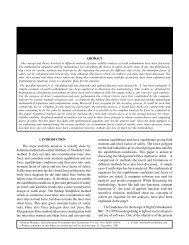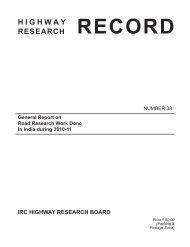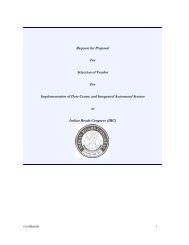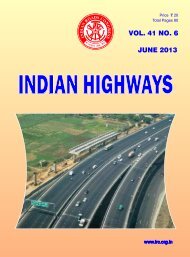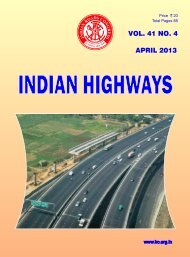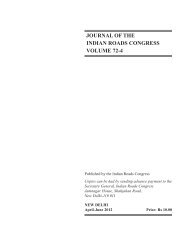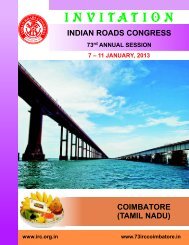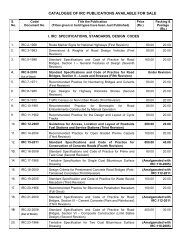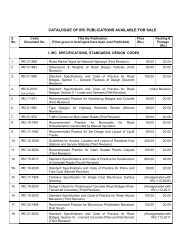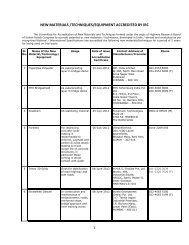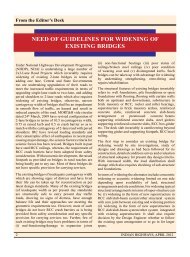Highway Research Record No. 39 - Indian Roads Congress
Highway Research Record No. 39 - Indian Roads Congress
Highway Research Record No. 39 - Indian Roads Congress
Create successful ePaper yourself
Turn your PDF publications into a flip-book with our unique Google optimized e-Paper software.
and Gujarat states; and design, construction and<br />
performance evaluation of new materials and mixes<br />
towards development and upgradation of standards /<br />
specifications.<br />
2. Geotechnical engineering<br />
The projects reported in the Geotechnical Engineering<br />
area relate to landslide Hazard Mitigation and<br />
Management on <strong>Indian</strong> <strong>Roads</strong> and <strong>Highway</strong>s, Site<br />
Stabilization work, Use of jute geotextiles in PMGSY<br />
roads to study efficacy of Jute Geotextile (JGT) and<br />
utilization of various solid industrial wastes in road works.<br />
Waste materials have been evaluated in the laboratory<br />
as well in the field by constructing experimental test<br />
sections. Performance observations are being taken up.<br />
The issues related with road infrastructure development<br />
in disaster prone areas have also received attention<br />
of researchers. Early warning system for landslides<br />
by simple and economical instrumentation like steel<br />
pedestals and DGPS, design and construction of roads<br />
in submerged/ flood affected areas of Rann of Kutch,<br />
Gujarat, formulation of guidelines for road construction<br />
in such areas have been reported. Design and<br />
construction of embankments in waterlogged areas by<br />
using fly ash, a novel construction methodology involving<br />
back-dumping of pond ash directly into water pond<br />
was also devised. CRRI- GTE Division is developing<br />
a non nuclear, non destructive type of equipment for<br />
determination of dry density of compacted soils.<br />
<strong>Research</strong> work has been performed on soil stabilization<br />
using commercially available materials, use of fly ash,<br />
copper slag, cinder waste, and phosphogypsum in<br />
subgrade and embankment construction. Based on<br />
laboratory data, it was found that in case of all the four<br />
types of soils as mentioned above, the unconfined<br />
compressive strength of soil stabilized with 2, 4 and 6<br />
Per cent cement gives higher strength as compared to<br />
with 2, 4 and 6 Per cent commercial stabiliser for 7, 14<br />
and 28 days curing period. The fly ash, bottom ash and<br />
pond ash samples can be used in embankment and<br />
road works. The study indicated that 10-15 Per cent of<br />
fine aggregate can be replaced by super fine slag. The<br />
optimum bitumen content was obtained as 4.8 Per cent<br />
and 5.5 Per cent respectively for DBM and BC mixes. The<br />
bituminous samples with superfine copper slag satisfied<br />
the design requirements as per MORTH specifications.<br />
A combination of waste recycled products and cinder<br />
can satisfy density requirements of the materials for the<br />
embankment construction. It was observed that both<br />
deflection and roughness characteristics of copper slag<br />
embankment was comparable to soil embankment. By<br />
providing geo-textiles the CBR value of weaker sub<br />
grades could be enhanced. Thereby, the pavement<br />
layer thickness can be considerably reduced and this<br />
facilitates the construction of roads in poor sub-grade<br />
ROAD RESEARCH IN INDIA 2011-12 3<br />
soil areas. SoilTech MK-III- engineered a SSB layer<br />
with much more strength then WMM (a ideal base<br />
course with more than 3000 Mpa strength). SoilTech<br />
MK-III-economized the project substantially. The<br />
ecological contribution of SoilTech MK-III used roads<br />
is excellent and over 50% then the conventional crust<br />
reducing man, machine and material consumption.<br />
3. Bridge engineering<br />
In this Chapter, the projects related to various aspects<br />
of bridges such as structural health monitoring,<br />
techniques for distress diagnostics, effect of corrosion on<br />
performance, remaining life assessment, strengthening<br />
techniques etc. are reported.<br />
Most of these projects are useful for Bridge<br />
Management, consisting of inventorization, condition<br />
assessment of the existing bridge with the help of<br />
inspection or NDTs, distress diagnostics, load carrying<br />
capacity evaluation of existing bridges with the help<br />
of analytical or experimental or a combination of both<br />
considering an appropriate degradation model, loading<br />
and environmental conditions, and choosing a suitable<br />
rehabilitation and strengthening techniques. All these<br />
aspects require in-depth knowledge, expertise as well<br />
as technology for which research is being carried out<br />
at a fast pace. Further, there is an immediate attention<br />
required for effective implementation of BMS in our<br />
country for prioritizing the maintenance of bridges in a<br />
road network.<br />
Indigenous design and development of tool for<br />
inspection of bridges such as Mobile Bridge Inspection<br />
Unit and Creation of Bridge Expansion Joint Test facility<br />
are of great interest to professionals.<br />
Also, the studies to assess the impact of noise and<br />
vibration levels after construction of transportation<br />
structure on built environment, their cause and remedial<br />
measure needs to be well taken at the planning stage<br />
of the infrastructure development.<br />
4. Traffic & Transportation<br />
4.1 planning and Management<br />
<strong>Research</strong> works reported in the area of Traffic<br />
Engineering, Transportation Planning and Management<br />
were briefly summarised in this section. In this section<br />
there are eight completed projects and eighteen<br />
new projects were reported. In this area most of the<br />
projects works were related to comprehensive traffic<br />
and transportation studies, route network planning,<br />
integration of Public Transportation, Urban speed<br />
management using ITS technologies. The salient area<br />
covered in this area are listed as follows:



